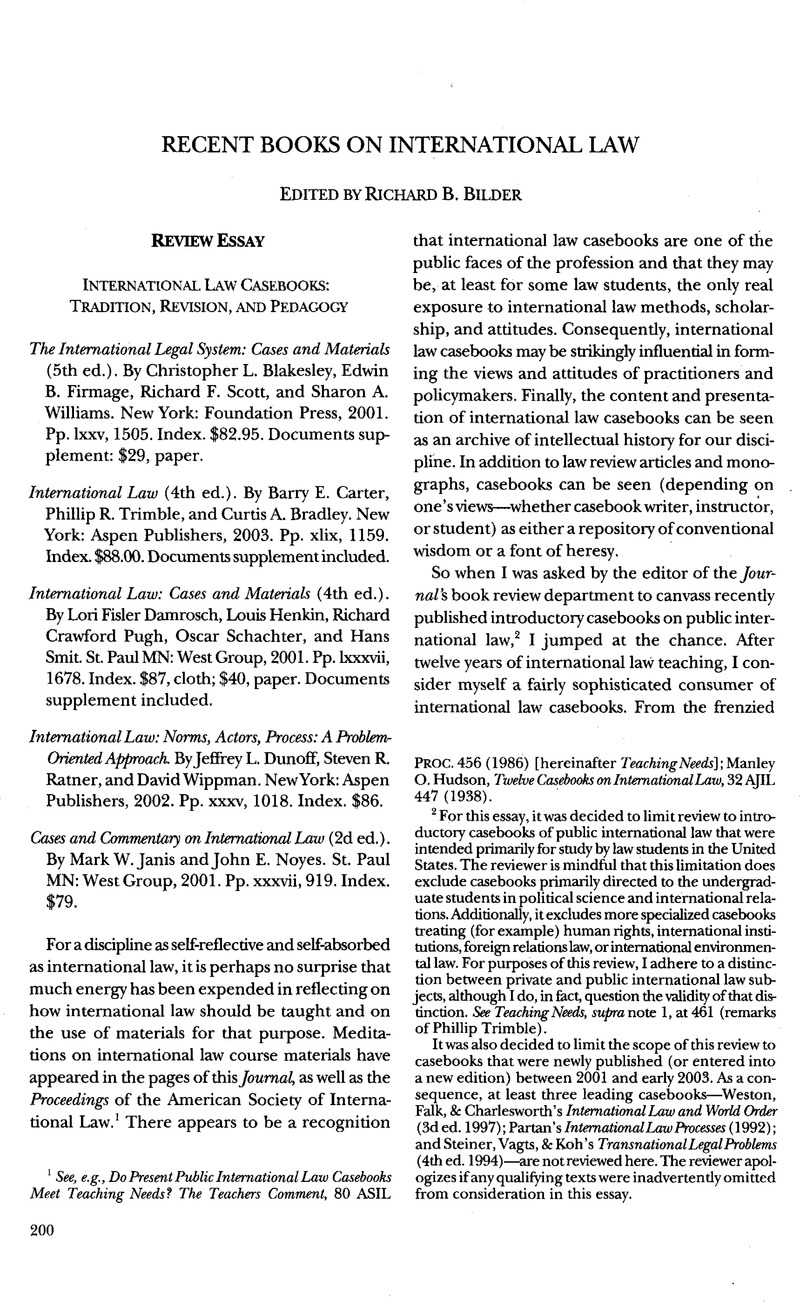No CrossRef data available.
Published online by Cambridge University Press: 27 February 2017

1 See, e.g., Do Present Public International Law Casebooks Meet Teaching Needs? The Teachers Comment, 80 ASIL Proc. 456 (1986)Google Scholar [hereinafter Teaching Needs]; Manley, O. Hudson, Twelve Casebooks on International Law, 32 AJIL 447 (1938).Google Scholar
2 For this essay, it was decided to limit review to introductory casebooks of public international law that were intended primarily for study by law students in the United States. The reviewer is mindful that this limitation does exclude casebooks primarily directed to the undergraduate students in political science and international relations. Additionally, it excludes more specialized casebooks treating (for example) human rights, international institutions, foreign relations law, or international environmental law. For purposes of this review, I adhere to a distinction between private and public international law subjects, although I do, in fact, question the validity of that distinction. See Teaching Needs, supra note 1, at 461 (remarks of Phillip Trimble).
It was also decided to limit the scope of this review to casebooks that were newly published (or entered into a new edition) between 2001 and early 2003. As a consequence, at least three leading casebooks—Weston, Falk, & Charlesworth’s International Law and World Order (3d ed. 1997)Google Scholar; Partan’s International Law Processes (1992)Google Scholar; and Steiner, Vagts, & Koh’s Transnational Legal Problems (4th ed. 1994)Google Scholar—are not reviewed here. The reviewer apologizes if any qualifying texts were inadvertently omitted from consideration in this essay.
3 See Eric, L. Muller, A New Law Teacher’s Guide to Choosing a Casebook, 45J. Legal Educ. 557 (1995).Google Scholar
4 See Lapiana, William, Logic and Experience: The Origin of Modern American Legal Education (1994)Google Scholar; Stephan, A. Siegel, John Chipman Gray and the Moral Basis of Classical Legal Thought, 86 Iowal. Rev. 1513, 1514 (2001)Google Scholar.
5 See Freeman Snow, Cases and Opinions on International Law: With Notes and a Syllabus iii (1893).
6 See James Brown, Scott, Cases of International Law Selected from Decisions of English and American Courts, with Syllabus and Annotations (1902) (2ded. 1906; 3d ed. 1922)Google Scholar.
7 See Hudson, supra note 1, at 448.
8 See id. at 448–49.
9 See Dunsford, John E., In Praise of Casebooks (A Personal Reminiscence), 44 St. Louis U. L.J. 821 (2000).Google Scholar
10 Gordon, A. Christenson, Book Review, 123 U. Pa. L. Rev. 1001, 1001 (1975)Google Scholar (reviewing Noyes, E. Leech, Covey, T. Oliver, & Joseph Modeste, Sweeney, Cases and Materials on the International Legal System (1973))Google Scholar.
11 See Teaching Needs, supra note 1, at 461 (remarks of Phillip Trimble).
12 I am not alone in making this particular criticism of the casebook. See Diane, P. Wood, Diffusion and Focus in International Law Scholarship, 1 Chi. J. Int’l L. 141, 147 & n.24 (2000)Google Scholar (citing the third edition of the casebook).
13 Robert, A. Sedler, Constitutional Law Casebooks: A View from the Podium, 79 Mich. L. Rev. 1020, 1026 (1981).Google Scholar
14 See Michael, D. Ramsey, Review Essay: Textbook Revisionism, 43 Va . J. Int’l L. 1111, 1120 (2003)Google Scholar (reviewing Curtis, A. Bradley & Jack, L. Goldsmith, Foreign Relations Law: Cases and Materials (2002)Google Scholar).
15 See Kennedy, David, International Law and the Nineteenth Century: History of an Illusion, 17 Quinnipiac L. Rev. 99, 106 (1997)Google Scholar; Religion and International Law, 82 ASIL Proc. 195, 198 (1988)Google Scholar (remarks of David Kennedy) (reviewing the second edition of this casebook); Comparative Approaches to the Theory of International Law, 80 ASIL Proc. 152, 163 (1986)Google Scholar (remarks of David Kennedy).
16 See Schachter, Oscar, The Invisible College of International Lathers, 72 Nw. U. L. Rev. 217 (1977).Google Scholar
17 See Henkin, Louis, That “S” Word: Sovereignty, and Globalization, and Human Rights, Et Cetera, 68 Fordham L. Rev. 1, 1 (1999).Google Scholar
18 Chayes, Abram, Ehrlich, Thomas & Andreas, F. Lowenfeld, International Legal Process: Materials for an Introductory Course (1968–69).Google Scholar
19 See, e.g., Wallace, Don Jr., Book Review, 83 Harv. L. Rev. 1947 (1970)CrossRefGoogle Scholar; Stanley, D. Metzger, Book Review, 2 N.Y.U.J. Int’l L. & Pol. 195, 198 (1969)Google Scholar. The casebook was in sharp contrast to William W. Bishop Jr.’s comprehensive and traditional International Law: Cases and Materials (first published 1953, with later editions in 1962 and 1971), a volume that the present reviewer used as a student in 1985.
20 See Harold Hongju, Koh, Why Do Nations Obey International Law? 106 Yale L. J. 2599 (1997)Google Scholar; Harold Hongju, Koh, Transnational Legal Process, 75 Neb. L. Rev. 181 (1996)Google Scholar; Anne-Marie, Slaughter, Andrew, S. Tulumello, & Wood, Stepan, International Law and International Relations Theory: A New Generation of Interdisciplinary Scholarship, 92 AJIL 367, 380 (1998).Google Scholar
21 See Teaching Needs, supra note 1, at 458-59 (remarks of Francis Boyle).
22 Henry, M. Hart Jr. & Albert, M. Sacks, the legal process (William, N. Eskridge Jr. & Philip, P. Frickey eds., 1994) (1958).Google Scholar
23 See Hudson, supra note 1, at 456.
24 See the comments in Teaching Needs, supra note 1, at 464.